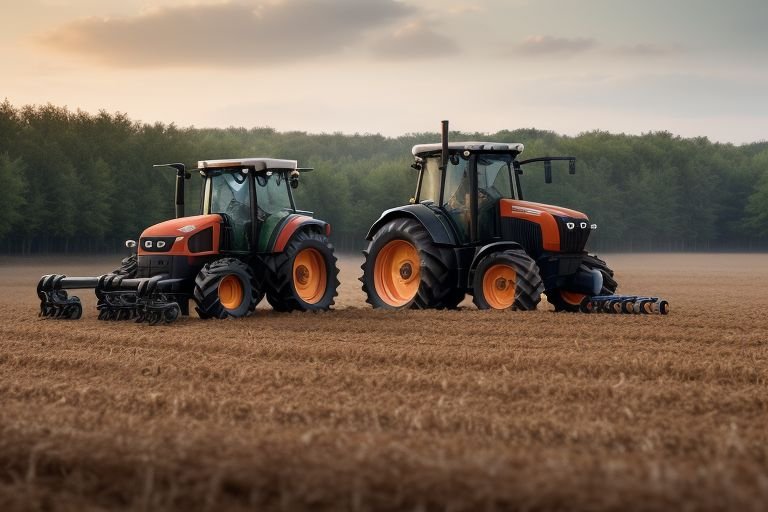The agtech industry is growing at an unprecedented rate with AI and robotics as the leading technologies for the transformation of farming. These innovations are solving some of the most pressing problems in agriculture ranging from labour, water and inputs to name but a few and are set to revolutionalise farming in the next few years.
According to AgFunder, a global agtech investment in 2023 hit the $30 billion and the leading niches among the startups were AI and robotics. This has led to rises in the investment that in turn is boosting the growth of autonomous farming equipment, precision agriculture technologies, and AI crop management systems.
Among them there is the most important one – the development of the autonomous tractors and harvesters. Agriculture equipment manufacturer John Deere has introduced its 8RX model, a self-driving tractor that can independently plow and sow fields and harvest crops. The machine employs camera, sensors, and machine learning algorithms to move in the fields and perform tasks with high accuracy. The first adopters have observed a reduction of labor cost by up to 50% in addition to improved productivity.
Robotics is also being applied in fruit and vegetable picking which has been one of the most labor demanding tasks. Organisations such as Abundant Robotics and Advanced. Farm have come up with high technological harvesters that are capable of picking apples and strawberries as if they were done by hand. These robots are equipped with computer vision and soft gripping technology to detect ripe fruit and pick it without bruising. Since most farmers are struggling with a lack of labor that is always available, these robotic harvesters provide a way of harvesting crops on time.
Unmanned aerial vehicles with imaging technologies incorporated in artificial intelligence are changing the face of crop monitoring and control. These aerial vehicles can cover vast stretch of farmland within the shortest time possible, detect pest infestation, nutrient deficiencies or irrigation problems that may not be visible to the naked eye. The information that is captured by drones is processed by artificial intelligence algorithms to give farmers recommendations which they can act on in good time.
The use of AI and IoT in precision agriculture is taking a new dimension and is becoming more complex. In fields, there are smart sensors that keep on monitoring the moisture, temperature, and nutrient content in the soil and send the information to central control. This data coupled with weather data and past yields’ data all feed into the AI algorithms to give highly specific recommendations for irrigation, fertilizer application, and pest control.
It is evident that these technologies have a considerable effect on the resource efficiency. Several researches indicate that the precision agriculture systems empowered by AI can decrease the water consumption by 30% and the fertilizer consumption by 20% and at the same time enhance the crop yields. It also helps increase farm income and decrease the negative effects of the agricultural business on the environment.
Vertical farming, which is a new way of practicing agriculture in urban areas is also on the receiving end when it comes to AI adup; robotics. Plenty and AeroFarms are some of the companies that have integrated AI in their growing system to monitor the growing conditions of their indoor farms including light, temperature and even feeding regimes. These are automated systems of planting, nurturing, and picking crops in controlled environment and allow production of fresh produce all year round in urban areas.
Another sector that is experiencing a lot of innovation is livestock farming. The application of AI in animal farming is in the regulation of animal’s health, the feeding regimen, and in some cases, identifying disease outbreaks before they happen. Automated milking has been widely adopted in many dairy farms as it enables cows to be milked at their own convenience and as well as avail health information of each cow.
The use of a blockchain with artificial intelligence and the internet of things is increasing the level of transparency in the agricultural supply chain. Each link in the production chain of a product is literally documented and audited, which gives the consumer a unique opportunity to know as much as possible about the product they are buying. It also has the capability of reducing food fraud, hence enhancing food safety.
However, there are still issues that need to be solved as to why agtech is not yet fully implemented across the globe. One of the major challenges is the high cost of investing in the technology where it is costly especially for the small scale farmers. Also, the increased use of advanced systems requires a skilled and literate human resource in the agricultural industry to fully utilize the technologies.
In order to tackle such issues, governments and agricultural agencies are coming up with strategies that help in the use of technology and skill enhancement. The USDA in the United States has recently unveiled a $500 million program that seeks to extend broadband connectivity in rural regions and offer education on digital agriculture tools. Such programs are being adopted in countries across the globe in acknowledgment of the importance of the technology in the future of farming.
With development of AI and robotics, questions of ethical nature are being raised more and more. Issues regarding ownership and control of data, privacy, and possible job losses for the agricultural workers are arising, and these are questions that are necessary for the development of responsible uses of these technologies.
The use of AI and robotics in agtech is making agriculture a highly technical profession and not a human-gut feeling business as it used to be. Some of the issues that can be solved by the shift include; labor issues, climate change, and environmental degradation. These technologies are set to expand in the future and become more affordable and efficient in the provision of food security for the increasing world population while at the same time being sustainable in the use of natural resources and in the face of climate change.




















+ There are no comments
Add yours